At the Administrative Appeals Tribunal (AAT), we give individuals and organisations the opportunity to have administrative decisions independently reviewed. We review decisions made by Australian Government ministers I departments and agencies and, in limited circumstances, decisions made by state and territory governments and some non-government bodies.
The types of decisions the AAT most commonly reviews relate to:
- Australian citizenship
- child support
- family assistance and social security
- migration and refugee visas
- the National Disability Insurance Scheme
- taxation
- veterans’ entitlements
- workers’ compensation under Commonwealth laws.
We also review a wide range of other decisions, however we can only review a decision if the law it is made under states that the decision can be reviewed by the AAT.
We aim to make our review processes accessible, fair, just, economical, informal, quick and proportionate.
We manage our workload in 9 divisions:
- Freedom of Information (FOI) Division
- General Division
- Migration and Refugee Division
- National Disability Insurance Scheme (NDIS) Division
- Security Division
- Small Business Taxation Division
- Social Services and Child Support Division
- Taxation and Commercial Division
- Veterans’ Appeals Division.
The AAT is led by President Justice Fiona Meagher, a judge of the Federal Court of Australia. It consists of other members appointed as Deputy Presidents, Senior Members and Members. The President is responsible for managing the administrative affairs of the AAT with the assistance of Deputy Presidents who are appointed as Division Heads and the Registrar, Michael Hawkins AM. The Registrar is the Accountable Authority and Agency Head of the AAT.
We also host the Immigration Assessment Authority (IAA), a separate office within the Migration and Refugee Division, which provides a fast track review process in relation to certain decisions to refuse protection (refugee) visas.
Key caseload statistics
The AAT received 18% more applications in 2021–22 than in the previous reporting period. We finalised a similar number of applications as the previous reporting year at 42,007 applications while the number of our on hand applications at 30 June 2022 had a 4% increase. The tables below show our key caseload statistics for 2021–22 and the preceding 6 years.
AAT caseload overview, 2015–16 to 2021–22
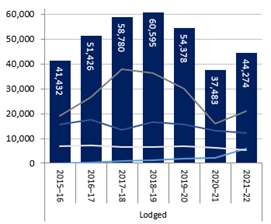
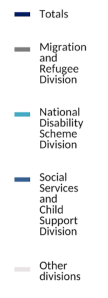
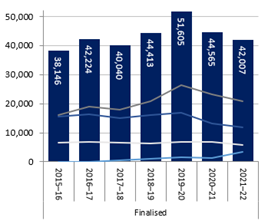
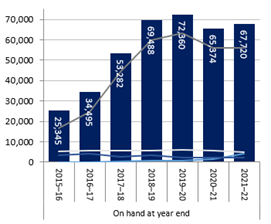
As in previous years, most of the applications made in 2021–22 were for reviews in the Migration and Refugee Division and the Social Services and Child Support Division. The size of our NDIS Division continued to increase as a proportion of the overall caseload.
Applications lodged, finalised and on hand, 2021–22 – By division
|
DIVISION
|
LODGED
|
FINALISED
|
ON HAND AT YEAR END
|
|
No
|
% of total
|
No
|
% of total
|
No
|
% of total
|
|
Freedom of Information
|
70
|
<1%
|
72
|
<1%
|
108
|
<1%
|
|
General
|
3,879
|
9%
|
4,514
|
11%
|
2,941
|
4%
|
|
Migration and Refugee
|
20,936
|
47%
|
20,892
|
50%
|
56,129
|
83%
|
|
National Disability Insurance Scheme
|
5,918
|
13%
|
3,348
|
8%
|
4,193
|
6%
|
|
Security
|
17
|
<1%
|
7
|
<1%
|
37
|
<1%
|
|
Small Business Taxation
|
317
|
<1%
|
297
|
<1%
|
469
|
<1%
|
|
Social Services and Child Support
|
12,138
|
27%
|
11,996
|
29%
|
2,342
|
3%
|
|
Taxation and Commercial
|
838
|
2%
|
685
|
2%
|
1,315
|
2%
|
|
Veterans’ Appeals
|
161
|
<1%
|
196
|
<1%
|
186
|
<1%
|
|
TOTAL
|
44,274
|
100%
|
42,007
|
100%
|
67,720
|
100%
|
Our review processes vary according to the type of decision being reviewed, reflecting differences in legislative requirements as well as specific approaches we have developed to deal with the broad range of decisions we review.
In the FOI, General, NDIS, Small Business Taxation, Taxation and Commercial, and Veterans’ Appeals Divisions, we use alternative dispute resolution (ADR) to help parties understand and narrow the issues in dispute, identify further evidence that will be gathered, and try to reach agreement about how their case could be resolved.
The overall number of ADR events increased significantly during the reporting period. There were 14,261 ADR events in 2021-22, compared to 10,766 in 2020–21. Despite the increase, our timeliness improved slightly during the reporting year with average days from lodgement to the last ADR event decreasing to 135 days compared with 144 days in the previous financial year.
Applications to the AAT may be finalised in different ways. This reporting year, we finalised more than half of all applications by making a decision, usually after conducting a hearing. Other methods of finalisation are set out below.
Mode of finalisation applications for review of decisions, 2021-22
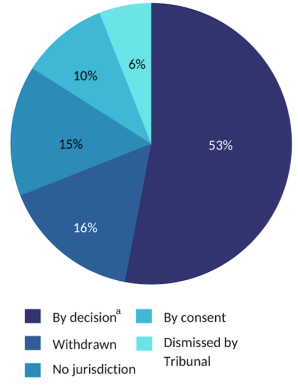
Outcomes of applications for review of decisions 2021-22
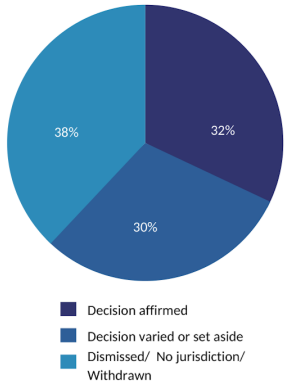
a'By decision’ includes applications finalised by a decision of the AAT on the merits under section 43 of the Administrative Appeals Tribunal Act or section 349 or 415 of the Migration Act. ‘No jurisdiction’ includes applications in relation to which the AAT cannot review the decision. ‘By consent’ includes applications finalised in accordance with terms of agreement reached by the parties.
NB: Percentages may not total 100% due to rounding
IAA key caseload statistics
The IAA received 906 referrals in 2021–22, similar to the 894 received in the previous reporting year. With an increase in the number of finalisations, we reduced our on hand IAA caseload from 212 at the end of 2020–21 to 41 at the end of 2021–22.
The median timeframe to finalise IAA cases increased from 5 weeks in the previous reporting year to 7 weeks in 2021–22. This was due to the complexity of referred cases in the remaining primary legacy caseload as well as the commencement of reviews of reassessments of subsequent temporary protection visa and safe haven enterprise visa applications.
In most cases, the IAA affirmed the decision under review (964 cases), with the decision remitted to the Department of Immigration for reconsideration in 97 cases. Sixteen cases were finalised on the basis that they were referred to the IAA in error.
|
|
REFERRALS
|
FINALISATIONS
|
ON HAND AT YEAR END
|
MEDIAN TIME TO FINALISE (WEEKS)
|
|
2020–21
|
894
|
788
|
212
|
5
|
|
2021–22
|
906
|
1077
|
41
|
7
|
The top 5 countries of reference of referred applicants in 2021–22 were Sri Lanka, Iran, Pakistan, Iraq, and Afghanistan. Sri Lanka remained the largest single source country of referrals overall and increased its proportion of the IAA’s caseload. Referrals from Pakistan and Iraq also increased proportionately, while the number of referrals from Bangladesh and Vietnam decreased during this period.
Our performance
Number of finalisations
The number of cases finalised is an indicator of the scale of activity undertaken by the AAT and IAA in carrying out our role of reviewing decisions. In 2021–22, we finalised a substantial number of applications and referrals, and reached 90% of our target, notwithstanding the ongoing challenges associated with the COVID-19 pandemic. The shortfall in meeting our target can be attributed primarily to lower than expected lodgements in certain areas of our work and increased complexity in some caseloads.
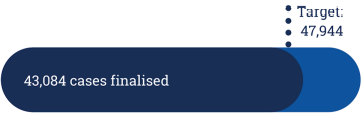
Clearance ratio
The clearance ratio is a measure of how many AAT applications and IAA referrals were finalised in the reporting year in relation to how many were received. We came close to achieving our clearance ratio target in 2021–22, having received 45,180 applications and referrals while finalising 43,084 applications and referrals. The total number of combined AAT and IAA cases on hand at 30 June 2022 (67,761) was 3% higher than at 30 June 2021.

Timeliness
This measure is an indicator of the extent to which the AAT and IAA are providing a mechanism for a review that is quick. In 2021–22, we fell short of our overall target of finalising 75% of cases within 12 months of lodgement. This is primarily a result of the AAT not having the financial and human resources to keep pace with the increase in lodgements over time.
We met targets in the NDIS, Small Business Taxation, and Social Services and Child Support Divisions as well as the IAA. There was a modest improvement in the Migration and Refugee Division, but timeliness is unlikely to improve in the forward years without additional resourcing as we work through the backlog of cases in this division.
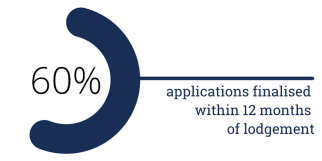
Publication of decisions
We publish statements of reasons for many of the decisions we make to promote public trust and confidence in our decision-making. We exceeded our 2021–22 target to publish at least 5,000 decisions, with 5,357 decisions published at the time of preparing our Annual Report. Our decisions can be found on the Australasian Legal Information Institute website (www.austlii.edu.au).
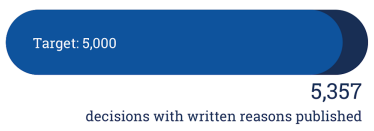
User feedback rating
We engage an independent research organisation to conduct an online survey each year to seek feedback from parties and representatives about their experiences of our services. In the survey, we ask users for their views on a range of aspects, including the process of applying for a review, the information we provide, dealings with staff, the experience of conferences and hearings, as well as perceptions of the process overall. The result for the survey conducted in 2021–22 exceeded our target of a rating of at least 70% by 4% and both parties and representatives continued to rate our services positively.
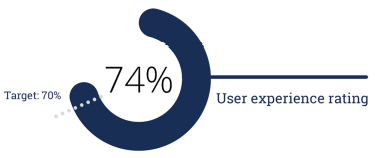
Judicial review outcomes
Some decisions made by the AAT and IAA may be appealed to the courts. An appeal may be allowed if there has been an error of law in relation to how the review was conducted or in reaching a decision. We aim to have fewer than 5% of appeals against our appealable decisions allowed by the courts. In 2021-22, 478 appeals of decisions made by the AAT and IAA were allowed. This was well under target at 1.9% of all appealable decisions from the previous year.
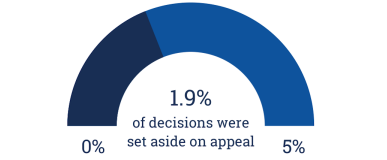
Key achievements in 2021–22
The AAT remained focused on providing high-quality merits review within a complex environment during the reporting period. We faced similar challenges as in previous years, relating to our ability to manage an increasing workload with the members and staff available, while the COVID-19 pandemic required ongoing adjustments to how we managed cases. Despite the challenges, the AAT and IAA continued to provide review services in accordance with our statutory objectives, enabling a substantial number of people and organisations to exercise their right to challenge administrative decisions, and contributing to government accountability and transparency.
We were able to finalise a high number of cases during the reporting year while building on the momentum of the previous reporting year to enhance our use of technology and modernise our digital operating environment. We improved the accessibility of our services, including by refining our hybrid model for holding video and phone hearings where appropriate, while recognising that some cases benefit from events being conducted in person. We refined our online services to give users a more consistent experience when communicating with us and better control over their applications. This meant we could centralise our contact points away from individual registries and offer our users the convenience of being able to lodge applications, submit documents and track existing applications online.
We made significant progress on our critical project to develop a single case management solution for the AAT during the reporting year.
During 2021–22, we worked with Government to progress legislative reforms that aim to reduce inconsistencies in the powers and procedures across our divisions. The Courts and Tribunals Legislation Amendment (2021 Measures No.1) Bill 2021 passed the Parliament on 14 February 2022 and use of these powers will commence in 2022–23.
Recognising our people are fundamental to the delivery of high-quality merits review. We continued to work towards ensuring our organisation has a positive culture, our members and staff have the right capabilities, and our workplace arrangements are fit for purpose. We maintained our focus on the health and wellbeing of members and staff. We also progressed towards reconciliation with the First Nations peoples by releasing a new Reconciliation Action Plan with a focus on those who work for us, as well as the Traditional Owners who use our services or are our suppliers.
More detailed information about the AAT and our operations can be found in our 2021–22 Annual Report, available on our website (www.aat.gov.au) and on the Australian Government Transparency Portal (www.transparency.gov.au).